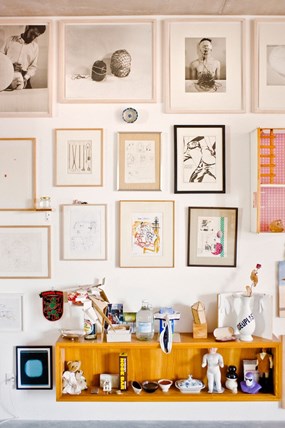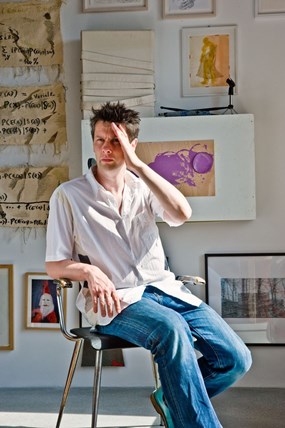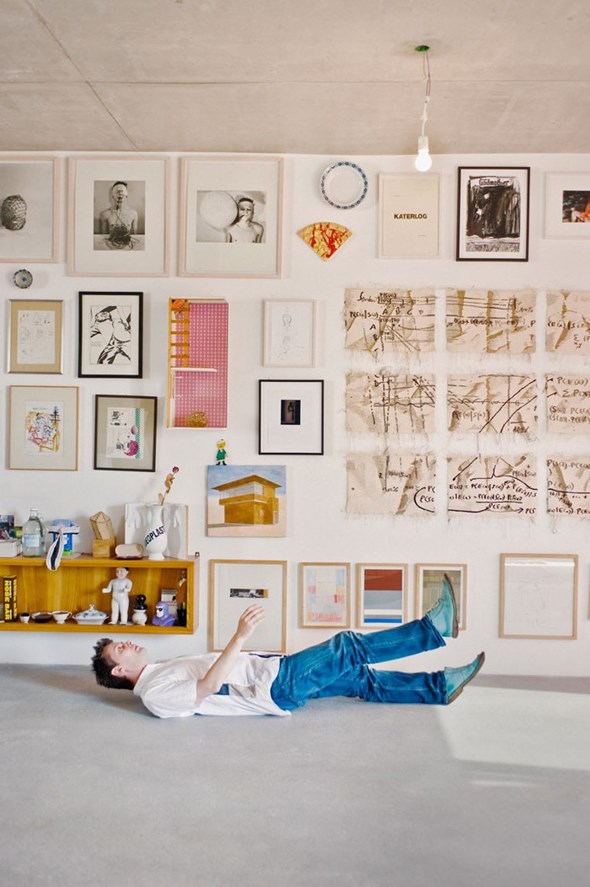

Photos: Jan Windszus
Staying fluid. Art-Habibi Bock
In Low German people speak of the brain as a spinning room, where the world spins itself into a thread. Since ANDREAS SCHLAEGEL has no direct access to JOHN BOCK’s brain, he makes an attempt to get closer to the artist’s spinning room through his collection, and gets quite tangled up.»Habibi, look!« comes shouted across the street. »Habibi, I’ve got no time!« John Bock shouts back. But the magnetism seems to be irresistible; we cross the street and look into a little shop filled with second-hand furniture somewhere between John Bock’s apartment and his atelier. John closely examines a rejected minibar refrigerator, takes two or three things in his hand and puts them back again, while the dealer praises some newly arrived metal shelves »with all their screws«. For the atelier perhaps? Or at home? John shakes his head, there’s nothing here this time. We take our leave: »Bye-bye Habibi«. »Habibi« means something like »my dear« in Turkish, and since the dealer calls it out to everyone who comes past, he has assumed the name himself.
The same thing very nearly happened to John Bock. The personas he creates in his actions and often embodies have all sorts of similarities with him, and many people confuse him with them. This rather driven-looking, slightly chaotic figure is what one imagines when the artist talks about the first artwork he ever bought. On a study trip to Vienna the student skipped some of the otherwise unavoidable excesses and went to an auction house instead. In a corner there was a cardboard box with the returns that had found no buyers. The student rummaged around and pulled out a little collage by Martin Kippenberger, who, in those days, was seen as a kind of art clown. The special price was exactly the amount the student had in cash with him; his travel budget was ruined in the meantime. But the economy was not so simple: with this purchase the student not only laid the foundation for a modest collection that reflected aspects of the collector’s own artistic work, but also demonstrated commitment to art ready to go to existential limits.
The collection of artworks purchased since then or acquired by bartering with artists he has befriended and admired is hardly, perhaps, in keeping with the grandiose image of a private collection as described constantly in the relevant media. These items would probably arouse little admiration among the Rubells, de la Cruzes and Saatchis. And the way the numerous editions of little objects by Heimo Zobernig, Georg Herold and others inhabit the artist’s living room, wandering over the CD shelf and spreading out next to the desk, has something of lovingly accumulated bric-a-brac about it. It reminds me of my favourite collections from literature, such as that of Moe Vernon, a rather unimportant secondary character in Alan Moore and Dave Gibbon’s classic comic The Watchmen. This Moe Vernon is the owner and boss of an automobile workshop, where the young super-hero Hooded Justice is employed. Moe Vernon’s collection consists of erotic bits and bobs such as salt and pepper shakers in the form of breasts, several pieces of plastic dog-shit or ballpoint pens where girls seen from a certain angle suddenly have no clothes on and similar tasteless things. »WhatI could not understand was why a grown man, without any obvious reason, would have an entire desk drawer full of these ridiculous things,« writes the super-hero in his memoirs. And yet he scarcely seems to notice that he himself is pursuing a much more absurd obsession, namely fighting for law and order in his highly theatrical costume.
It was also from this point of view that I looked at John Bock’s Klütterkammer exhibition in the London ICA 2004, a positively monstrous mixture of retrospective, stage set, viewer participation and a delirious artist /curator tour de force: a kind of externalised, theatricalised and therefore in some way idealised John Bock collection. Some of the obvious influences were represented there, such as Kippenberger, Paul McCarthy and Otto Muehl, woven into a crazy labyrinth. One screen there was reserved entirely for Douglas Hickox’s horror-film classic Theatre of Blood (1973), where Vincent Price plays an actor who gets rid of his mean-spirited critics in constantly new charades. The artist shares his pleasure in grand guignol productions with the Existentialist Rudolf Schwarzkogler, who might be called one of the sacred icons of the Bock universe, even if he was called an »aesthete« in a rather pejorative way by his colleague Hermann Nitsch. But it is precisely this approach to staging things in a totally white room especially for photographic purposes that must have fascinated John Bock, for some of the artist’s Vintage Prints hang here on the walls.
Next to them are drawings by Matt Mullican, with whom the artist shares the gallery, and a small work on paper with applied pieces of glass by Thilo Heinzmann, who also has a surprise guest appearance in one of Bock’s catalogues, just like Bendix Harms, whom Bock invited to collaborate with Anton Kern in New York. The borderline between private and professional world is blurred here; life and art are simply too directly bound up with each other, and interdisciplinary work is the basic principle. Rather than a division like that between Superman and Clark Kent, a many-faced multiplicity dominates, where the artist remains recognisable in spite of his elaborate costumes. Similarly, his artistic interests and influences remain comprehensible, almost as in a diary, and are not intended for the public, even though the artist has injected an autobiographical canon into his work, from Gribbohm to Berlin.
We should not forget other sacred icons: musically, apart from The Cure there is first of all Alice Cooper, and then, of course, the band Blackmail, who produced the soundtrack for John Bock’s Magnum opus, the rock opera Maltreated Frigate. And then there is an – until now – underestimated repertoire of apparently passive figures, architectural and sculptural forms, through which Bock’s personas have to wind their way, a seemingly endless series of ground and air vehicles, spaces and tunnels, houses, labyrinths, ladders and towers, bunkers … And don’t let me even start on the costumes. Once I was there when two policemen surprised John Bock and his troupe filming a performance in the woods. They thought they had caught a whole gang unloading garbage in the woods on a major scale. A long discussion developed on the meaning of art in the woods, ending with a fee to be paid for a special permit for an »unregistered theatre performance in the forest«. I don’t know which collection the alleged garbage has ended up in today, but the picture the two policemen made is something I would like to have for my own John Bock collection: a clearing in the forest around an ensemble of drugstore products, foodstuffs, half-buried, deconstructed furniture and electronic gear, a person in a strange self-assembled costume with a melon on his head, black painted eyes and buried up to his hips in the ground. And a somewhat deranged Elvis imitator – that was me.
In the universe of John Bock the term collection is correct in its original meaning – an assembly that, more than anything else, indicates a network that binds the artist with this history of art and the art world. When I asked John Bock one day whether there was anything the artists he collected had in common, he responded with a kind of artistic view of the world, according to which there are two artistic ambitions: one tries to grasp things and hold them, the other tries to make things fluid. You have three guesses.
Translated by Nelson Wattie
ANDREAS SCHLAEGEL is a Berlin based artist, critic and plays the drums in the Art Critics Orchestra.
JOHN BOCK (*1965 in Gribbohm / D) lives in Berlin. Recent solo shows include Gio Marconi, Mailand (2008), Klosterfelde, Berlin (2007), Sadie Coles HQ, London (2007), Regen Projects, Los Angeles (2007) and Schirn Kunsthalle, Frankfurt (2007). Exhibiton participations include Pivot Points Part 1, Museum of Contemporary Art, Miami (2008), Constructing New Berlin, Phoenix Art Museum (2006), documenta 11 (2002) and Biennale Venedig (1998).
The same thing very nearly happened to John Bock. The personas he creates in his actions and often embodies have all sorts of similarities with him, and many people confuse him with them. This rather driven-looking, slightly chaotic figure is what one imagines when the artist talks about the first artwork he ever bought. On a study trip to Vienna the student skipped some of the otherwise unavoidable excesses and went to an auction house instead. In a corner there was a cardboard box with the returns that had found no buyers. The student rummaged around and pulled out a little collage by Martin Kippenberger, who, in those days, was seen as a kind of art clown. The special price was exactly the amount the student had in cash with him; his travel budget was ruined in the meantime. But the economy was not so simple: with this purchase the student not only laid the foundation for a modest collection that reflected aspects of the collector’s own artistic work, but also demonstrated commitment to art ready to go to existential limits.
The collection of artworks purchased since then or acquired by bartering with artists he has befriended and admired is hardly, perhaps, in keeping with the grandiose image of a private collection as described constantly in the relevant media. These items would probably arouse little admiration among the Rubells, de la Cruzes and Saatchis. And the way the numerous editions of little objects by Heimo Zobernig, Georg Herold and others inhabit the artist’s living room, wandering over the CD shelf and spreading out next to the desk, has something of lovingly accumulated bric-a-brac about it. It reminds me of my favourite collections from literature, such as that of Moe Vernon, a rather unimportant secondary character in Alan Moore and Dave Gibbon’s classic comic The Watchmen. This Moe Vernon is the owner and boss of an automobile workshop, where the young super-hero Hooded Justice is employed. Moe Vernon’s collection consists of erotic bits and bobs such as salt and pepper shakers in the form of breasts, several pieces of plastic dog-shit or ballpoint pens where girls seen from a certain angle suddenly have no clothes on and similar tasteless things. »WhatI could not understand was why a grown man, without any obvious reason, would have an entire desk drawer full of these ridiculous things,« writes the super-hero in his memoirs. And yet he scarcely seems to notice that he himself is pursuing a much more absurd obsession, namely fighting for law and order in his highly theatrical costume.
It was also from this point of view that I looked at John Bock’s Klütterkammer exhibition in the London ICA 2004, a positively monstrous mixture of retrospective, stage set, viewer participation and a delirious artist /curator tour de force: a kind of externalised, theatricalised and therefore in some way idealised John Bock collection. Some of the obvious influences were represented there, such as Kippenberger, Paul McCarthy and Otto Muehl, woven into a crazy labyrinth. One screen there was reserved entirely for Douglas Hickox’s horror-film classic Theatre of Blood (1973), where Vincent Price plays an actor who gets rid of his mean-spirited critics in constantly new charades. The artist shares his pleasure in grand guignol productions with the Existentialist Rudolf Schwarzkogler, who might be called one of the sacred icons of the Bock universe, even if he was called an »aesthete« in a rather pejorative way by his colleague Hermann Nitsch. But it is precisely this approach to staging things in a totally white room especially for photographic purposes that must have fascinated John Bock, for some of the artist’s Vintage Prints hang here on the walls.
Next to them are drawings by Matt Mullican, with whom the artist shares the gallery, and a small work on paper with applied pieces of glass by Thilo Heinzmann, who also has a surprise guest appearance in one of Bock’s catalogues, just like Bendix Harms, whom Bock invited to collaborate with Anton Kern in New York. The borderline between private and professional world is blurred here; life and art are simply too directly bound up with each other, and interdisciplinary work is the basic principle. Rather than a division like that between Superman and Clark Kent, a many-faced multiplicity dominates, where the artist remains recognisable in spite of his elaborate costumes. Similarly, his artistic interests and influences remain comprehensible, almost as in a diary, and are not intended for the public, even though the artist has injected an autobiographical canon into his work, from Gribbohm to Berlin.
We should not forget other sacred icons: musically, apart from The Cure there is first of all Alice Cooper, and then, of course, the band Blackmail, who produced the soundtrack for John Bock’s Magnum opus, the rock opera Maltreated Frigate. And then there is an – until now – underestimated repertoire of apparently passive figures, architectural and sculptural forms, through which Bock’s personas have to wind their way, a seemingly endless series of ground and air vehicles, spaces and tunnels, houses, labyrinths, ladders and towers, bunkers … And don’t let me even start on the costumes. Once I was there when two policemen surprised John Bock and his troupe filming a performance in the woods. They thought they had caught a whole gang unloading garbage in the woods on a major scale. A long discussion developed on the meaning of art in the woods, ending with a fee to be paid for a special permit for an »unregistered theatre performance in the forest«. I don’t know which collection the alleged garbage has ended up in today, but the picture the two policemen made is something I would like to have for my own John Bock collection: a clearing in the forest around an ensemble of drugstore products, foodstuffs, half-buried, deconstructed furniture and electronic gear, a person in a strange self-assembled costume with a melon on his head, black painted eyes and buried up to his hips in the ground. And a somewhat deranged Elvis imitator – that was me.
In the universe of John Bock the term collection is correct in its original meaning – an assembly that, more than anything else, indicates a network that binds the artist with this history of art and the art world. When I asked John Bock one day whether there was anything the artists he collected had in common, he responded with a kind of artistic view of the world, according to which there are two artistic ambitions: one tries to grasp things and hold them, the other tries to make things fluid. You have three guesses.
Translated by Nelson Wattie
ANDREAS SCHLAEGEL is a Berlin based artist, critic and plays the drums in the Art Critics Orchestra.
JOHN BOCK (*1965 in Gribbohm / D) lives in Berlin. Recent solo shows include Gio Marconi, Mailand (2008), Klosterfelde, Berlin (2007), Sadie Coles HQ, London (2007), Regen Projects, Los Angeles (2007) and Schirn Kunsthalle, Frankfurt (2007). Exhibiton participations include Pivot Points Part 1, Museum of Contemporary Art, Miami (2008), Constructing New Berlin, Phoenix Art Museum (2006), documenta 11 (2002) and Biennale Venedig (1998).

